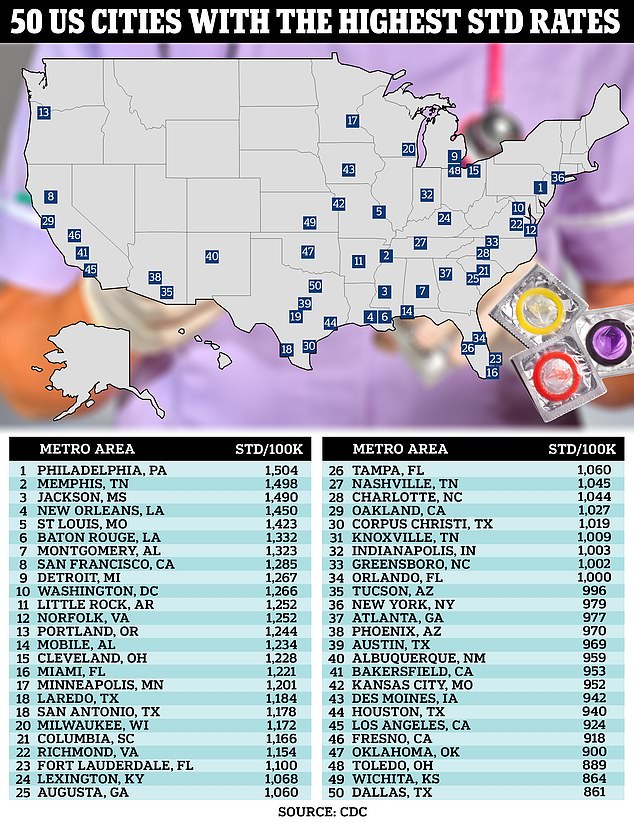Doctors are being told to consider prescribing a “morning after pill” after sex to tackle the national explosion in STD infections.
The CDC today released new guidance recommending that the antibiotic doxycycline be prescribed within 72 hours of unprotected oral, vaginal, or anal sex with a new or repeat partner.
Studies suggest the drug could prevent up to 70 percent of chlamydia and syphilis infections and up to 50 percent of gonorrhea cases.
It works by killing bacteria before they become so advanced that they cause symptoms and can be transmitted to other people.
It comes amid an “STD epidemic” in the United States, where nearly 700,000 more Americans contract chlamydia, gonorrhea or syphilis each year compared to before the Covid pandemic.
Philadelphia reported the highest rate of STDs in 2022, closely followed by Memphis and Jackson, Mississippi.
The new recommendations apply to gay men, bisexual men, and transgender women with a history of at least one STI.
But it may also be available to heterosexual men and women if they go to the doctor for fear of having been exposed to an STI.
The guide, published today, says that for these groups “Providers should use clinical judgment and shared decision-making to inform use.”
Patients receiving the treatment will also need to be tested for STIs starting as early as three and six months after taking the medication.
Doxycycline for STIs is prescribed at a dose of 200 milligrams (mg) to be taken twice a day for seven days.
Its only goal is to reduce the risk of STIs, while the traditional morning-after pill, Plan B, must still be taken within 72 hours of unprotected sex to prevent unwanted pregnancy.
Officials said they were recommending the course, called doxycycline post-exposure prophylaxis (Doxy-PEP), for gay and bisexual men because this group is disproportionately affected by STIs.

Innerbody researchers reported that rates of chlamydia, gonorrhea, and syphilis are increasing at “concerning rates” in the US.

Dr. Philip Andrew Chan, who consults with the CDC on doxycycline recommendations, said using an antibiotic to prevent STDs will not be “a magic bullet” but rather “another tool.”
This group has higher rates of syphilis than the general population and still accounts for more than half of all new HIV infections.
Officials said: ‘Doxy PEP represents the first new STI prevention tool in decades, at a time when innovation is desperately needed in the country’s fight against STIs.
“These guidelines will be updated as more data becomes available.”
Doxycycline has been used in the US since it was approved in 1967 and is taken in 60-day cycles of two pills per day.
It is available by prescription, and about 9 million are prescribed each year to treat everything from a chest and dental problem to a skin infection such as rosacea and STIs.
It is not always prescribed for bacterial STIs; The CDC recommends azithromycin for chlamydia, ceftriaxone for gonorrhea, and penicillin for syphilis.
Infections are already becoming resistant to these drugs, and concerns were raised last year about two cases of supergonorrhea (or antibiotic-resistant gonorrhea) detected in Boston, Massachusetts.
But there are concerns that prescribing doxycycline to treat infections could have the same effect.
Studies suggest that about five percent of chlamydia infections may already be resistant to doxycycline, and resistance is likely already present in gonorrhea and syphilis.
Studies suggest that there was no marked increase in resistance when doxy-PEP was used, but there was an increase in resistance levels among Staph bacteria, which can cause throat infections, increasing from five to 13 percent.
Doxycycline is also associated with side effects including vomiting or diarrhea, headaches, and feelings of nausea.
It comes amid an explosion of STIs in the US, with every state seeing cases of syphilis and gonorrhea increasing between 2017 and 2022, the latest data available.
Only chlamydia, the most common STD in the United States, seemed to be causing fewer infections, but there are fears that this is because fewer tests were being done.
Scientists fear that the rise in STIs is due to riskier sexual behavior and a reduction in condom use.
Experts are particularly concerned about rising rates of syphilis because the disease can cause birth defects in developing fetuses.
The latest guideline was based on three studies of gay and bisexual men who received 200 milligrams (mg) of doxycycline within 72 hours of sexual intercourse.
This included a 2022 trial conducted in San Francisco and Seattle, where 501 gay and bisexual men and transgender women who had not previously used a condom during sex were given doxycycline up to 72 hours after sex.
And a 2022 trial in France involved 332 people who received doxycycline within 72 hours of sex, with a history of sex without a condom.
Participants were followed for 96 weeks, and results showed a 50 percent reduction in the risk of gonorrhea infection and up to a 90 percent reduction in the risk of chlamydia or gonorrhea infection.
The recommendation follows a public consultation on the measure, which was first revealed in April last year.


